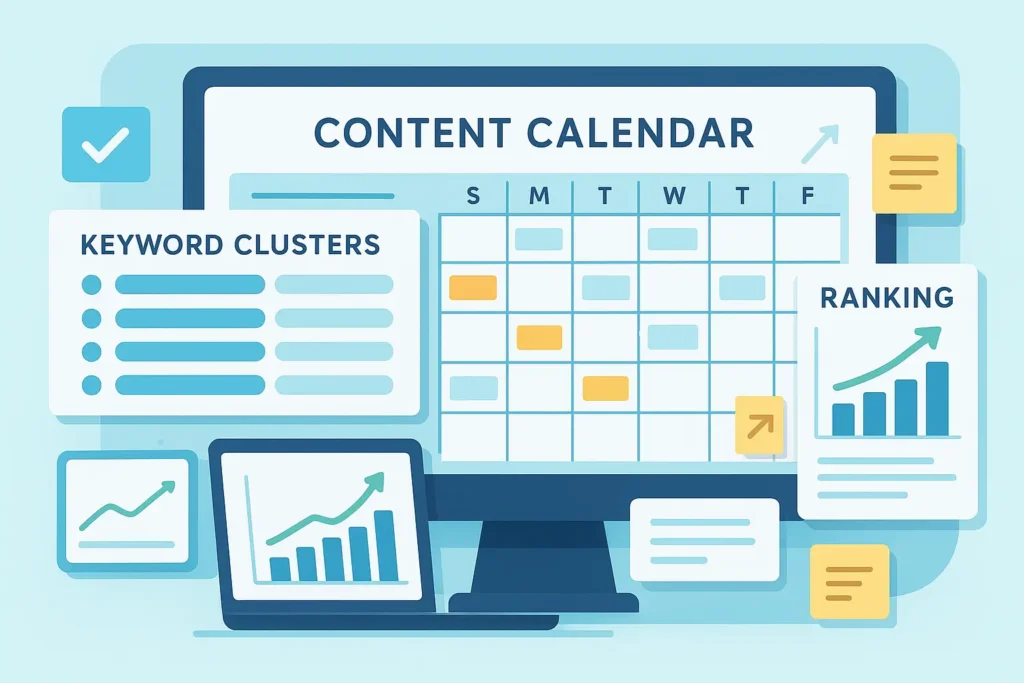Understanding Quarterly SEO Planning
Quarterly growth depends on consistent planning. A content calendar and a keyword map form the backbone of this process. Instead of producing random articles, a structured quarterly approach ensures each piece supports rankings, traffic gains, and conversions. This strategy focuses on intent alignment, seasonal demand, and ongoing competitive changes.
Why Content Calendars Matter for Scalable SEO
A content calendar is more than a posting schedule. It becomes a workflow system that connects search demand with business goals. With clear timelines and topic clustering, teams avoid duplicate content and maintain steady publishing momentum. Quarterly visibility spikes come from consistent execution, not one-off posts.
Key elements of a strong SEO content calendar
- Publication frequency aligned with growth goals
- Search intent grouped into clusters
- Deadlines that sync with optimization cycles
- Seasonal or promotional timing integrated into the schedule
By planning each quarter in advance, you reduce guesswork, speed up production, and keep the entire SEO pipeline predictable.
Building Keyword Maps for Quarterly Execution
A keyword map organizes your topics, target pages, and intent categories. It tells you what to write, why it matters, and where it fits within your site. It also ensures you avoid keyword cannibalisation while hitting the right ranking opportunities.
What a quarterly keyword map must include
- Primary keywords linked to specific URLs
- Secondary variations and semantic terms
- Search intent classification
- Ranking difficulty compared with competitor pages
- Notes on content gaps and internal linking paths
A good keyword map is updated every quarter to reflect fresh data, competitor movement, and shifting SERP patterns.
Using SEOsets Data for Accurate Planning
SEOsets provides keyword trends, content gaps, competitor benchmarks, and ranking health insights. These data points help shape the content calendar and keyword map into actionable quarterly plans. The platform highlights missed opportunities, declining pages, and rising demand that should be prioritized for the next 90 days.
How SEOsets data improves quarterly planning
- Identifies keywords with rising search volume
- Reveals gaps competitors are exploiting
- Shows which pages need fresh supporting content
- Pinpoints new clusters suitable for next quarter
- Helps assign deadlines based on ranking urgency
Once insights are collected, the content calendar and keyword map merge into a single quarterly plan that tells your team exactly what to produce, optimize, and promote.
To access deeper insights, users can explore SEOsets directly.
Putting It All Together for Quarterly Growth
Quarterly growth comes from predictable SEO execution, not from sporadic posting. A combined content calendar and keyword map remove uncertainty and give your team a system to follow. With accurate data at the core, each quarter becomes easier to plan and significantly more effective.
FAQs
How often should a keyword map be updated?
Updating once every quarter is ideal because search trends and SERPs shift rapidly.
Can a content calendar work for small teams?
Yes. Even a simple quarterly calendar prevents duplication and allows consistent publishing.
Do keyword maps help with internal linking?
Absolutely. They show which content pieces belong in the same cluster, making internal linking easier and more strategic.
Should all quarterly content target high volume keywords?
No. Mix high volume, medium difficulty, and easy long tail keywords for balanced growth.


